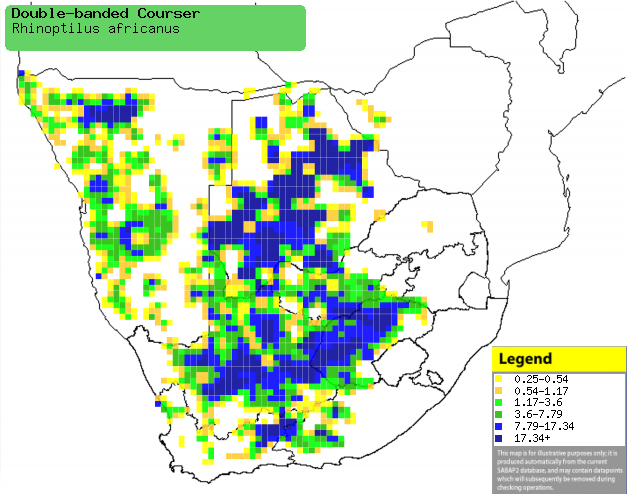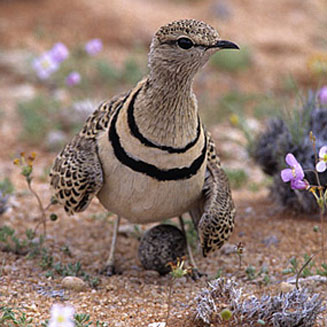|
Rhinoptilus africanus
(Double-banded courser)
[= Smutsornis africanus]
Dubbelbanddrawwertjie [Afrikaans]; Segolagola, Segelegwele
[Tswana]; Dubbelbandrenvogel [Dutch]; Courvite à double collier [French];
Doppelband-rennvogel [German]; Corredor-de-duas-golas [Portuguese]
Life
> Eukaryotes >
Opisthokonta
> Metazoa (animals) >
Bilateria >
Deuterostomia > Chordata >
Craniata > Vertebrata (vertebrates) > Gnathostomata (jawed
vertebrates) > Teleostomi (teleost fish) > Osteichthyes (bony fish) > Class:
Sarcopterygii (lobe-finned
fish) > Stegocephalia (terrestrial
vertebrates) > Tetrapoda
(four-legged vertebrates) > Reptiliomorpha > Amniota >
Reptilia (reptiles) >
Romeriida > Diapsida > Archosauromorpha > Archosauria >
Dinosauria
(dinosaurs) > Saurischia > Theropoda (bipedal predatory dinosaurs) >
Coelurosauria > Maniraptora > Aves
(birds) >
Order: Charadriiformes > Family: Glareolidae
Distribution and habitat
Occurs in two separate areas of sub-Saharan Africa, in
Somalia and Ethiopia, Tanzania, Kenya and southern Africa. Within southern
Africa it is
locally fairly common in Namibia, Botswana, and central South Africa, generally
preferring open plains with short grass and patches of bare ground adjacent to
pans, shrublands, stony or gravelly semi-desert, dry and flat riverbeds and
eroded or overgrazed grassland.
|
 |
|
Distribution of Double-banded courser in southern Africa,
based on statistical smoothing of the records from first SA Bird Atlas
Project (©
Animal Demography unit, University of
Cape Town; smoothing by Birgit Erni and Francesca Little). Colours range
from dark blue (most common) through to yellow (least common).
See here for the latest distribution
from the SABAP2. |
Movements and migrations
Mainly resident, although it may local
movements in search of more dry areas, such as the Kalahari.
Food
It mainly eats insects, especially ants, Northern harvester
termites (Hodotermes mossambicus) and beetles (Coleoptera),
doing most of its foraging by running after prey and jabbing at them its bill.
Breeding
- Monogamous solitary nester, performing a courtship display in which the
male dances in semi circles around the female with short hopping steps.
- The eggs are placed directly on bare ground (as in the photo below),
sometimes with a ring of pebbles, plant matter or antelope droppings
surrounding them.
 |
|
|
Double-banded courser incubating its egg, Aggeneys,
South Africa. [photo Warwick Tarboton ©] |
|
- Egg-laying season is year-round, peaking from August-December.
- It lays a single egg, which is incubated by both sexes for about 25
days, changing shifts every 1.5-2.0 hours.
- The chick leave the nest within 24 hours of hatching, although staying
close to the nest until 3-4 days old, at which point it joins its parents.
Both adults feed the chick with small insects until it fledges at about 5-6
weeks old.
Threats
Not threatened, in fact it is common and widespread and has
benefited from overgrazing and erosion in certain areas.
References
-
Hockey PAR, Dean WRJ and Ryan PG 2005. Roberts
- Birds of southern Africa, VIIth ed. The Trustees of the John Voelcker
Bird Book Fund, Cape Town.
|
